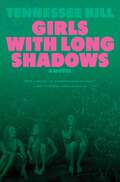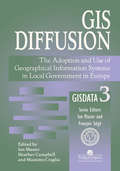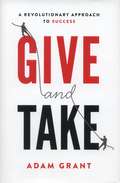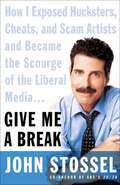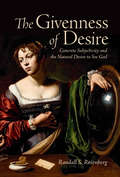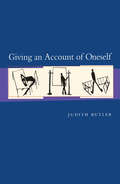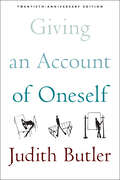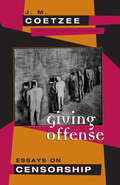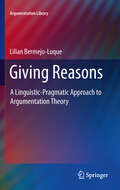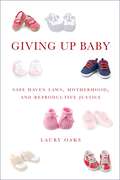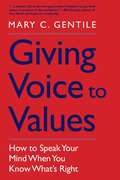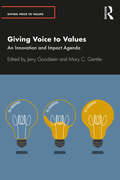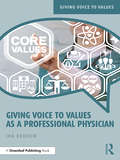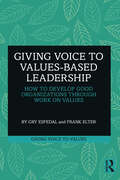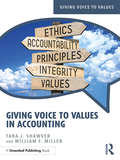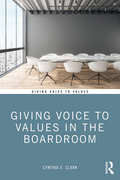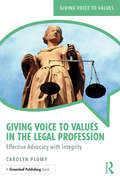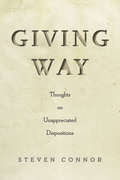- Table View
- List View
Girls on the Stand: How Courts Fail Pregnant Minors
by Helena SilversteinChoice Outstanding Academic Title for 2008The U.S. Supreme Court has decided that states may require parental involvement in the abortion decisions of pregnant minors as long as minors have the opportunity to petition for a &#“bypass” of parental involvement. To date, virtually all of the 34 states that mandate parental involvement have put judges in charge of the bypass process. Individual judges are thereby responsible for deciding whether or not the minor has a legitimate basis to seek an abortion absent parental participation. In this revealing and disturbing book, Helena Silverstein presents a detailed picture of how the bypass process actually functions.Silverstein led a team of researchers who surveyed more than 200 courts designated to handle bypass cases in three states. Her research shows indisputably that laws are being routinely ignored and, when enforced, interpreted by judges in widely divergent ways. In fact, she finds audacious acts of judicial discretion, in which judges structure bypass proceedings in a shameless and calculated effort to communicate their religious and political views and to persuade minors to carry their pregnancies to term. Her investigations uncover judicial mandates that minors receive pro-life counseling from evangelical Christian ministries, as well as the practice of appointing attorneys to represent the interests of unborn children at bypass hearings.Girls on the Stand convincingly demonstrates that safeguards promised by parental involvement laws do not exist in practice and that a legal process designed to help young women make informed decisions instead victimizes them. In making this case, the book casts doubt not only on the structure of parental involvement mandates but also on the naïve faith in law that sustains them. It consciously contributes to a growing body of books aimed at debunking the popular myth that, in the land of the free, there is equal justice for all.
Girls with Long Shadows: A Novel
by Tennessee Hill"A brilliant, engrossing portrait of three sisters and the bonds of love and betrayal. . . . Hill is a gifted talent and I look forward to more."—Jill McCorkle, New York Times bestselling author of Life After Life"Singular, striking, and sly, Girls with Long Shadows seduced me from its first sentence to its last. This book has so much scathing beauty in it I could feel the scrape of a knife on every page. What a delicate, hot-blooded tempest of a debut."—Amy Jo Burns, author of MercuryWith the haunting, romantic voyeurism of The Virgin Suicides and the atmosphere and emotional intensity of Where the Crawdads Sing, an intoxicating Southern Gothic debut novel about identical triplets whose lives are devastated when their burgeoning desires turn deadly.Identical triplets Baby A, Baby B, and Baby C Binderup were welcomed into the world as their mother was ushered out of it, leaving them nameless and in the care of their Gram, Isadora. Nineteen years later, the triplets work at their Gram’s crumbling golf course in Longshadow, Texas, where the ever-watchful eyes of the town observe them serving up glasses of ice-cold lemonade to golfers, swimming in the murky waters of the neighboring bayou, or slipping t-shirts off their sunburnt shoulders in hopes of attracting the kind of attention they are only beginning to understand.Cautious Baby B watches as lustful Baby A and introverted Baby C find matches among the town boys. Even Baby B has noticed that the town’s golden boy seems to be intrigued by her, only her. Just as each girl’s desire to be seen for herself is becoming fulfilled, a seemingly trivial kiss is bestowed on the wrong sister, leading to a moment of unspeakable violence that will upend the triplets’ world forever.Pulsating with menace and narrated with hypnotic lyricism, Girls with Long Shadows is an electrifying literary thriller that captures how female teenage angst can turn lethal when insecurities are weaponized and sibling bonds are severed. Tense, lush, and painfully beautiful, it forces us to consider the lengths to which we will go to claim our own personhood.
GIS and Housing: Principles and Practices (GIS in Action)
by Laxmi Ramasubramanian Jochen Albrecht Deborah Rojas De LeonGIS and Housing: Principles and Practices discusses one of the challenges that has not been addressed by Geographic Information Science thus far: how can we use GIS to deal with the complex issues underlying the housing crisis? This book provides GIS technicians and analysts with an overview of US housing challenges and examples of how to effectively integrate spatial thinking to address housing policy questions, while simultaneously introducing housing policy analysts to advanced GIS concepts and techniques to create livable neighborhoods that include housing alternatives beyond the single family. Through numerous examples, the authors advocate for a collaborative approach that encourages professionals, policymakers, and analysts, across different ideological and political perspectives, to confront the multifaceted housing crisis. Features: Examines the historical aspects of housing provision, societal attitudes, demographic shifts, and government policies. Bridges the gaps between housing professionals and GIS experts, facilitating an interdisciplinary approach to address the housing crisis. Explores different challenges that are facing urban, suburban, and rural neighborhoods in different US regions. Provides professionals with the necessary tools for informed decision-making. Proposes solutions that leverage the integrative capacity of GIS to address established housing issues. Advocates for denser housing alternatives to address issues of affordability, supply shortages, and homelessness. This book is intended for graduate students and professionals in housing, community development, urban planning, architecture, and GIS, and anyone curious about learning more about the American housing crisis.
GIS Diffusion: The Adoption And Use Of Geographical Information Systems In Local Government in Europe
by Ian Masser; Heather Campbell; Massimo CragliaThis third book in the GISDATA series focuses on the widespread use of geographical information systems GIS in European local government. The editors include a wide range of applications carried out by different professional groups, and offer the opportunity of studying the extent to which diffusion of innovations like GIS are sensitive to national issues such as cultural context, institutional setup and the availability of data.; The book answers key questions such as: what can be learnt from research on organizational behaviour in relation to technological innovation?; what are the classical features of the GIS diffusion process?; to what extent is the adoption and utilization of GIS facilitated - or impeded - by the organizational culture within which it takes place?; and what mechanisms can be applied to enhance the diffusion of GIS? The book covers aspects of diffusion in the following European countries: UK, France, Italy, Poland, Denmark, The Netherlands, Germany, Greece and Portugal.
GIS in Hospital and Healthcare Emergency Management
by GISP, Ric SkinnerAlthough many books have been published on the application of GIS in emergency management and disaster response, this is the first one to bring together a comprehensive discussion of the critical role GIS plays in hospital and healthcare emergency management and disaster response. Illustrating a wide range of practical applications, GIS in Hospital
GIS in Law Enforcement: Implementation Issues and Case Studies (International Forensic Science And Investigation Ser.)
by Mark R. Leipnik Donald P. AlbertThis is the ideal book for GIS users in law enforcement who want to learn more about the technology or who wish to get started using GIS in their agency. Crime analysts, teachers, and students of criminal justice will also gain valuable insights into a suite of powerful technological tools ideally suited for crime mapping and analysis from this com
Give and Take: A Revolutionary Approach to Success
by Adam M. GrantAn innovative, groundbreaking book that will captivate readers of Malcolm Gladwell, Daniel Pink, The Power of Habit, and Quiet. For generations, we have focused on the individual drivers of success: passion, hard work, talent, and luck. But today, success is increasingly dependent on how we interact with others. It turns out that at work, most people operate as either takers, matchers, or givers. Whereas takers strive to get as much as possible from others and matchers aim to trade evenly, givers are the rare breed of people who contribute to others without expecting anything in return. Using his own pioneering research as Wharton's youngest tenured professor, Grant that shows these styles have a surprising impact on success. Although some givers get exploited and burn out, the rest achieve extraordinary results across a wide range of industries. Combining cutting-edge evidence with captivating stories, this landmark book shows how one of America's best networkers developed his connections, why the creative genius behind one of the most popular shows in television history toiled for years in anonymity, how a basketball executive responsible for multiple draft busts transformed his franchise into a winner, and how we could have anticipated Enron's demise four years before the company collapsed--without ever looking at a single number. Praised by bestselling authors such as Dan Pink, Tony Hsieh, Dan Ariely, Susan Cain, Dan Gilbert, Gretchen Rubin, Bob Sutton, David Allen, Robert Cialdini, and Seth Godin--as well as senior leaders from Google, McKinsey, Merck, Estée Lauder, Nike, and NASA-- Give and Take highlights what effective networking, collaboration, influence, negotiation, and leadership skills have in common. This landmark book opens up an approach to success that has the power to transform not just individuals and groups, but entire organizations and communities.
Give Me a Break: How I Exposed Hucksters, Cheats, and Scam Artists and Became the Scourge of the Liberal Media...
by John Stossel“Immensely thought-provoking,”* Emmy Award–winning TV presenter John Stossel’s Give Me a Break exposes the hypocrisy and corruption of the U.S. government.Working as a correspondent for 20/20 and Good Morning America, John Stossel confronted dozens of scam artists: from hacks who worked out of their basements to some of America’s most powerful executives and leading politicians. His efforts shut down countless crooks—both famous and obscure. Then he realized what the real problem was.In Give Me a Break, Stossel takes on the regulators, lawyers, and politicians who thrive on our hysteria about risk and deceive the public in the name of safety. Drawing on his vast professional experience (as well as some personal ones), Stossel presents an engaging, witty, and thought-provoking argument about the beneficial powers of the free market and free speech.“Powerful, well-argued.” —*Booklist
Give Me Liberty: A History of America's Exceptional Idea
by Richard BrookhiserAn award-winning historian recounts the history of American liberty through the stories of thirteen essential documentsNationalism is inevitable: It supplies feelings of belonging, identity, and recognition. It binds us to our neighbors and tells us who we are. But increasingly -- from the United States to India, from Russia to Burma -- nationalism is being invoked for unworthy ends: to disdain minorities or to support despots. As a result, nationalism has become to many a dirty word.In Give Me Liberty, award-winning historian and biographer Richard Brookhiser offers up a truer and more inspiring story of American nationalism as it has evolved over four hundred years. He examines America's history through thirteen documents that made the United States a new country in a new world: a free country. We are what we are because of them; we stay true to what we are by staying true to them.Americans have always sought liberty, asked for it, fought for it; every victory has been the fulfillment of old hopes and promises. This is our nationalism, and we should be proud of it.
The Givenness of Desire: Concrete Subjectivity and the Natural Desire to See God
by Randall S. RosenbergIn The Givenness of Desire, Randall S. Rosenberg examines the human desire for God through the lens of Lonergan’s "concrete subjectivity." Rosenberg engages and integrates two major scholarly developments: the tension between Neo-Thomists and scholars of Henri de Lubac over our natural desire to see God and the theological appropriation of the mimetic theory of René Girard, with an emphasis on the saints as models of desire. With Lonergan as an integrating thread, the author engages a variety of thinkers, including Hans Urs von Balthasar, Jean-Luc Marion, René Girard, James Alison, Lawrence Feingold, and John Milbank, among others. The theme of concrete subjectivity helps to resist the tendency of equating too easily the natural desire for being with the natural desire for God without at the same time acknowledging the widespread distortion of desire found in the consumer culture that infects contemporary life. The Givenness of Desire investigates our paradoxical desire for God that is rooted in both the natural and supernatural.
Giving an Account of Oneself
by Judith ButlerWhat does it mean to lead a moral life?In her first extended study of moral philosophy, Judith Butler offers a provocative outline for a new ethical practice—one responsive to the need for critical autonomy and grounded in a new sense of the human subject.Butler takes as her starting point one’s ability to answer the questions “What have I done?” and “What ought I to do?” She shows that these question can be answered only by asking a prior question, “Who is this ‘I’ who is under an obligation to give an account of itself and to act in certain ways?” Because I find that I cannot give an account of myself without accounting for the social conditions under which I emerge, ethical reflection requires a turn to social theory.In three powerfully crafted and lucidly written chapters, Butler demonstrates how difficult it is to give an account of oneself, and how this lack of self-transparency and narratibility is crucial to an ethical understanding of the human. In brilliant dialogue with Adorno, Levinas, Foucault, and other thinkers, she eloquently argues the limits, possibilities, and dangers of contemporary ethical thought.Butler offers a critique of the moral self, arguing that the transparent, rational, and continuous ethical subject is an impossible construct that seeks to deny the specificity of what it is to be human. We can know ourselves only incompletely, and only in relation to a broader social world that has always preceded us and already shaped us in ways we cannot grasp. If inevitably we are partially opaque to ourselves, how can giving an account of ourselves define the ethical act? And doesn’t an ethical system that holds us impossibly accountable for full self-knowledge and self-consistency inflict a kind of psychic violence, leading to a culture of self-beratement and cruelty? How does the turn to social theory offer us a chance to understand the specifically social character of our own unknowingness about ourselves?In this invaluable book, by recasting ethics as a project in which being ethical means becoming critical of norms under which we are asked to act, but which we can never fully choose, Butler illuminates what it means for us as “fallible creatures” to create and share an ethics of vulnerability, humility, and ethical responsiveness.
Giving an Account of Oneself: Twentieth Anniversary Edition, with a new preface by the author
by null Judith ButlerWhat does it mean to lead a moral life? In their first extended study of moral philosophy, Judith Butler offers a provocative outline for a new ethical practice—one responsive to the need for critical autonomy yet grounded in the opacity of the human subject. Butler takes as their starting point one’s ability to answer the questions “What have I done?” and “What ought I to do?” They show that these questions can be answered only by asking a prior question, “Who is this ‘I’ who is under an obligation to give an account of itself and to act in certain ways?” Because I find that I cannot give an account of myself without accounting for the social conditions under which I emerge, ethical reflection requires a turn to social theory. In three powerfully crafted and lucidly written chapters, Butler demonstrates how difficult it is to give an account of oneself, and how this lack of self-transparency and narratibility is crucial to an ethical understanding of the human. In dialogue with Adorno, Levinas, Foucault, and other thinkers, they eloquently argue the limits, possibilities, and dangers of contemporary ethical thought. Butler offers a critique of the moral self, arguing that the transparent, rational, and continuous ethical subject is an impossible construct that seeks to deny the specificity of what it is to be human. We can know ourselves only incompletely, and only in relation to a broader social world that has always preceded us and already shaped us in ways we cannot grasp. If inevitably we are partially opaque to ourselves, how can giving an account of ourselves define the ethical act? And doesn’t an ethical system that holds us impossibly accountable for full self-knowledge and self-consistency inflict a kind of psychic violence, leading to a culture of self-beratement and cruelty? How does the turn to social theory offer us a chance to understand the specifically social character of our own unknowingness about ourselves? By recasting ethics as a project in which being ethical means becoming critical of norms under which we are asked to act, but which we can never fully choose, Butler illuminates what it means for us as “fallible creatures” to create and share an ethics of vulnerability, humility, and ethical responsiveness.
Giving Back: Connecting You, Business, and Community
by Bert Berkeley Peter EconomyThere is something exciting happening in businesses across the country. More business-people and more companies than ever are participating in charitable activities and are learning that giving back is not a slogan--it is a way of doing business and a way of life. Giving Back reveals how fundamental and lasting changes are being accomplished in communities and highlights highly effective organizations from a number of major metropolitan areas, including Kiva.org, Horizons for Homeless Children, the Annie E. Casey Foundation, LINC, Stonyfield Farm Profits for the Planet, and many more. -amazon.com
Giving It All Away: The Story of William W. Cook and His Michigan Law Quadrangle
by Margaret A. Leary"Margaret Leary's carefully researched book illuminates a complex man who marked his university in a truly enduring way. " ---Francis X. Blouin Jr. , Director, Bentley Historical Library, and Professor, School of Information and Department of History, University of Michigan "Generations of Michigan Law grads have passed on myths about their generous but eccentric benefactor. . . . Now Margaret Leary has given us the real story, and it reads like a gripping whodunit. " ---Theodore J. St. Antoine, James E. and Sarah A. Degan Professor Emeritus of Law and Past Dean, University of Michigan Law School "In an absorbing book, Margaret Leary unstintingly investigates unpublished, archival material to unravel enigmas surrounding William Wilson Cook. She brings to life Cook's brilliant interactions with powerful moguls of the early twentieth century as she traces his lofty, philanthropic mission to elevate the legal profession. " ---Ilene H. Forsyth, Arthur F. Thurnau Professor of the History of Art, emerita, University of Michigan William W. Cook, born in 1858 and a graduate of the University of Michigan and of its law school, made his fortune by investing in the burgeoning telegraph and communications industry, as well as in representing the Mackay Company in their frequent tumultuous battles with Western Union and the U. S. government. Though Cook entered New York society and never returned to Michigan after receiving his law degree, he decided not just to give his alma mater the finest physical facility of any existing law school, but to donate permanent resources that would permit the law school to engage in groundbreaking legal research. However, his generosity proved controversial and eventually very litigious. Margaret A. Leary places Cook's story in the rich social and cultural context of his time and paints a fascinating portrait of a complex figure whose legacy continues to shape the University of Michigan. Cover photographs: (left) Gregory Fox Photography; (right) Ann B. Cook collection, photo by Russell R. Serbay
Giving Offense: Essays on Censorship
by J. M. CoetzeeJ.M. Coetzee presents a coherent, unorthodox analysis of censorship from the perspective of one who has lived and worked under its shadow. The essays collected here attempt to understand the passion that plays itself out in acts of silencing and censoring. He argues that a destructive dynamic of belligerence and escalation tends to overtake the rivals in any field ruled by censorship.
Giving Reasons
by Lilian Bermejo LuqueThis book provides a new, linguistic approach to Argumentation Theory. Its main goal is to integrate the logical, dialectical and rhetorical dimensions of argumentation in a model providing a unitary treatment of its justificatory and persuasive powers. This model takes as its basis Speech Acts Theory in order to characterize argumentation as a second-order speech act complex. The result is a systematic and comprehensive theory of the interpretation, analysis and evaluation of arguments. This theory sheds light on the many faces of argumentative communication: verbal and non-verbal, monological and dialogical, literal and non-literal, ordinary and specialized. The book takes into consideration the major current comprehensive accounts of good argumentation (Perelman's New Rhetoric, Pragma-dialectics, the ARG model, the Epistemic Approach) and shows that these accounts have fundamental weaknesses rooted in their instrumentalist conception of argumentation as an activity oriented to a goal external to itself. Furthermore, the author addresses some challenging meta-theoretical questions such as the justification problem for Argumentation Theory models and the relationship between reasoning and arguing.
Giving Up Baby: Safe Haven Laws, Motherhood, and Reproductive Justice
by Laury Oaks“Baby safe haven” laws, which allow a parent to relinquish a newborn baby legally and anonymously at a specified institutional location—such as a hospital or fire station—were established in every state between 1999 and 2009. Promoted during a time of heated public debate over policies on abortion, sex education, teen pregnancy, adoption, welfare, immigrant reproduction, and child abuse, safe haven laws were passed by the majority of states with little contest. These laws were thought to offer a solution to the consequences of unwanted pregnancies: mothers would no longer be burdened with children they could not care for, and newborn babies would no longer be abandoned in dumpsters.Yet while these laws are well meaning, they ignore the real problem: some women lack key social and economic supports that mothers need to raise children. Safe haven laws do little to help disadvantaged women. Instead,advocates of safe haven laws target teenagers, women of color, and poor women with safe haven information and see relinquishing custody of their newborns as an act of maternal love. Disadvantaged women are preemptively judged as “bad” mothers whose babies would be better off without them.Laury Oaks argues that the labeling of certain kinds of women as potential “bad” mothers who should consider anonymously giving up their newborns for adoption into a “loving” home should best be understood as an issue of reproductive justice. Safe haven discourses promote narrow images of who deserves to be a mother and reflect restrictive views on how we should treat women experiencing unwanted pregnancy.
Giving Voice to Values
by Mary C. GentileThis small volume presents directly applicable ideas and tasks that teach the reader how to feel empowered to speak up and persist in speaking up for what's right in the work place. Gentile (Babson College, Wellesley, Mass.) fashions the principles behind the concepts into a clear set of skills for action, with the belief that most people know the difference between right and wrong but are hindered for many reasons in speaking up in the workplace. Ethics, psychology, and philosophy are part of the text's content, but the main focus is on values and action, how to overcome fear of conflict, understand the motivation of others, look ahead to see risk, communicate with others, and generally feel empowered to act for what's right in the workplace. An appendix contains extensive study aids for the reader and materials for peer-coaching. Annotation ©2010 Book News, Inc. , Portland, OR (booknews.com)
Giving Voice to Values: An Innovation and Impact Agenda (Giving Voice to Values)
by Jerry Goodstein; Mary C. GentileGiving Voice to Values, under the leadership of Mary Gentile, has fundamentally changed the way business ethics and values-driven leadership is taught and discussed in academic and corporate settings worldwide. This book shifts attention to the future of Giving Voice to Values (GVV) and provides thought pieces from practitioners and leading experts in business ethics and the professions on the possibilities for sustaining its growth and success. These include the creation of new teaching materials, reaching different audiences, and expanding the ways in which GVV is making a difference in classrooms and the workplace and acting as a catalyst for organizational and societal change. The book closes with a reflective chapter by Mary Gentile, looking back at where GVV has been and looking ahead to where GVV might go.
Giving Voice to Values as a Professional Physician: An Introduction to Medical Ethics (Giving Voice to Values)
by Ira BedzowGiving Voice to Values as a Professional Physician provides students with the theoretical background and practical applications for acting on their values in situations of ethical conflict. It is the first medical ethics book that utilizes the Giving Voice to Values methodology to instruct students in medical ethics and professionalism. In doing so, it shifts the focus of ethics education from intellectually examining ethical theories and conflicts to emphasizing moral action. Each section of the book explains how moral decision-making and action can be implemented in the healthcare arena. Medical ethics cases are provided throughout in order to assist students in giving voice to their values and developing skills for professional action. The Giving Voice to Values methodology, and the cases in this book, do not focus on the big questions of academic ethics, but rather on the ethics of the everyday, even if the challenges presented are difficult. In other words, the ethical questions students will have to face, in this book and in medical education and practice, are about how to interact with others, whether they be patients or colleagues, who might have different ethical positions. The book provides a unique guide for professional identity formation and the teaching of ethics in medical schools.
Giving Voice to Values-based Leadership: How to Develop Good Organizations Through Work on Values (Giving Voice to Values)
by Gry Espedal Frank ElterThe complexity facing today’s organizations calls for a rethinking of leadership. The world is facing grand challenges for people and the planet. Leaders and employees bear the responsibility of formulating strategies grounded in strong values. These strategies aim to foster the growth of sustainable organizations and promote ethical work practices. This book gives voice to values-based leadership and provides a method for leaders to develop a values-based organizational culture. Values play a role on many levels in how we work as individual leaders, in teams, and in organizations and in how organizations approach societal challenges. Values can be a compass or orientation point, giving direction for decisions and actions. Awareness of values can make organizational responsibilities clearer and give a sense of meaning to work and help leaders to create organizations where corporate, moral, and social values are embedded at every level. This book gives insight into a Scandinavian values-based leadership model built on the institutional leadership tradition. It provides processes and practices that leaders can use to develop organizations where values are continuously nurtured. The book provides practical ideas of how leaders can work on becoming conscious of both the organization’s explicit and implicit values, as well as working on the direction of the organization and its broader organizational culture. This book will be an invaluable resource for both practitioners and graduate students interested in leadership and organizational development.
Giving Voice to Values in Accounting (Giving Voice to Values)
by Tara J. Shawver William F. MillerThere has been much written on the importance of responsibility accounting and integrated reporting to ensure business accountability, but not on how to be a responsible accountant. As the accounting profession is built on the foundation of maintaining public trust, making the right decisions when faced with a challenging dilemma has a major impact on the long-term performance and perception of the firm as well as personal credibility. Accountants make judgement calls on a regular basis: they are privy to highly confidential information regarding their clients and their clients' businesses. Unethical earnings management practices can easily lead to falsifying records, but how does the accounting professional avoid succumbing to these practices when faced with other pressures? Giving Voice to Values in Accounting is the first book to explain the ethical dilemmas faced by accountants in their day-to-day work and to provide clear guidance for accounting students and professionals in navigating through these issues. The Giving Voice to Values (GVV) framework focuses on resolving ethical conflict by encouraging individuals to act on their values. This book provides accounting educators, coaches, trainers and professionals with both the impetus and the tools to easily implement the GVV offering into their own work, their organizations and in the classroom.
Giving Voice to Values in the Boardroom (Giving Voice to Values)
by Cynthia E. ClarkThis book takes the central issues facing board members today and applies the giving voice to values framework while also providing insights from practicing board members who have faced these issues. It covers such topics as strategic planning and monitoring, director independence, privacy and cyber risk, executive compensation and CEO succession planning. With this book, readers will also grapple with the conflicts of interest that might arise in the director selection process, role of the nominating committee and the compensation committee in order to cultivate more optimal board dynamics. The principles of giving voice to values start by asking a deceptively simple question: ‘What if you were going to act on your values—what would you say and do?’ The book then provides an overview of the current landscape of corporate governance along with the major rules and director duties applicable to the board of directors. The book’s latter chapters contain a series of five scenarios common to the board of directors that are presented as a set of “Board Challenges” involving the tensions often found in board work. In Giving Voice to Values in the Boardroom, the author, Cynthia E. Clark, provides practical strategies for board members and other constituents of corporate governance to deal with these challenges. These cases are designed to help users of the book implement prescripting and action planning. Each case will also have discussion questions about the stakes and stakeholders, common reasons and rationalizations and examples of how firms and governance professionals have handled similar board challenges.
Giving Voice to Values in the Legal Profession: Effective Advocacy with Integrity (Giving Voice to Values)
by Carolyn PlumpEthical issues do not occur in isolation. Instead, real-life situations arise in the workplace alongside other pressing issues such as job security, career advancement, peer pressure, manager evaluations, and company profits. For this reason, students and employees in law need concise and common sense guidance that provides a framework for how to voice one's values in the midst of competing interests. This book does just that. By providing twelve accessible scenarios drawn from real-life examples, this book walks readers through some of the most common ethical issues they will face in the workplace and how to address them in a manner that is realistic and effective. There are two clear reasons to read Giving Voice to Values in the Legal Profession. First, it is practical. The book presents information that is readily useful to students as they move forwards in their personal lives and careers. Second, the book is concise and easy to add to an existing course. It can provide a context for discussing a myriad of issues around ethics in the legal profession.
Giving Way: Thoughts on Unappreciated Dispositions
by Steven ConnorIn a world that promotes assertion, agency, and empowerment, this book challenges us to revalue a range of actions and attitudes that have come to be disregarded or dismissed as merely passive. Mercy, resignation, politeness, restraint, gratitude, abstinence, losing well, apologizing, taking care: today, such behaviors are associated with negativity or lack. But the capacity to give way is better understood as positive action, at once intricate and demanding. Moving from intra-human common courtesies, to human-animal relations, to the global civility of human-inhuman ecological awareness, the book's argument unfolds on progressively larger scales. In reminding us of the existential threat our drives pose to our own survival, Steven Connor does not merely champion a family of behaviors; he shows that we are more adept practitioners of them than we realize. At a time when it is on the wane, Giving Way offers a powerful defense of civility, the versatile human capacity to deflect aggression into sociability and to exercise power over power itself.

